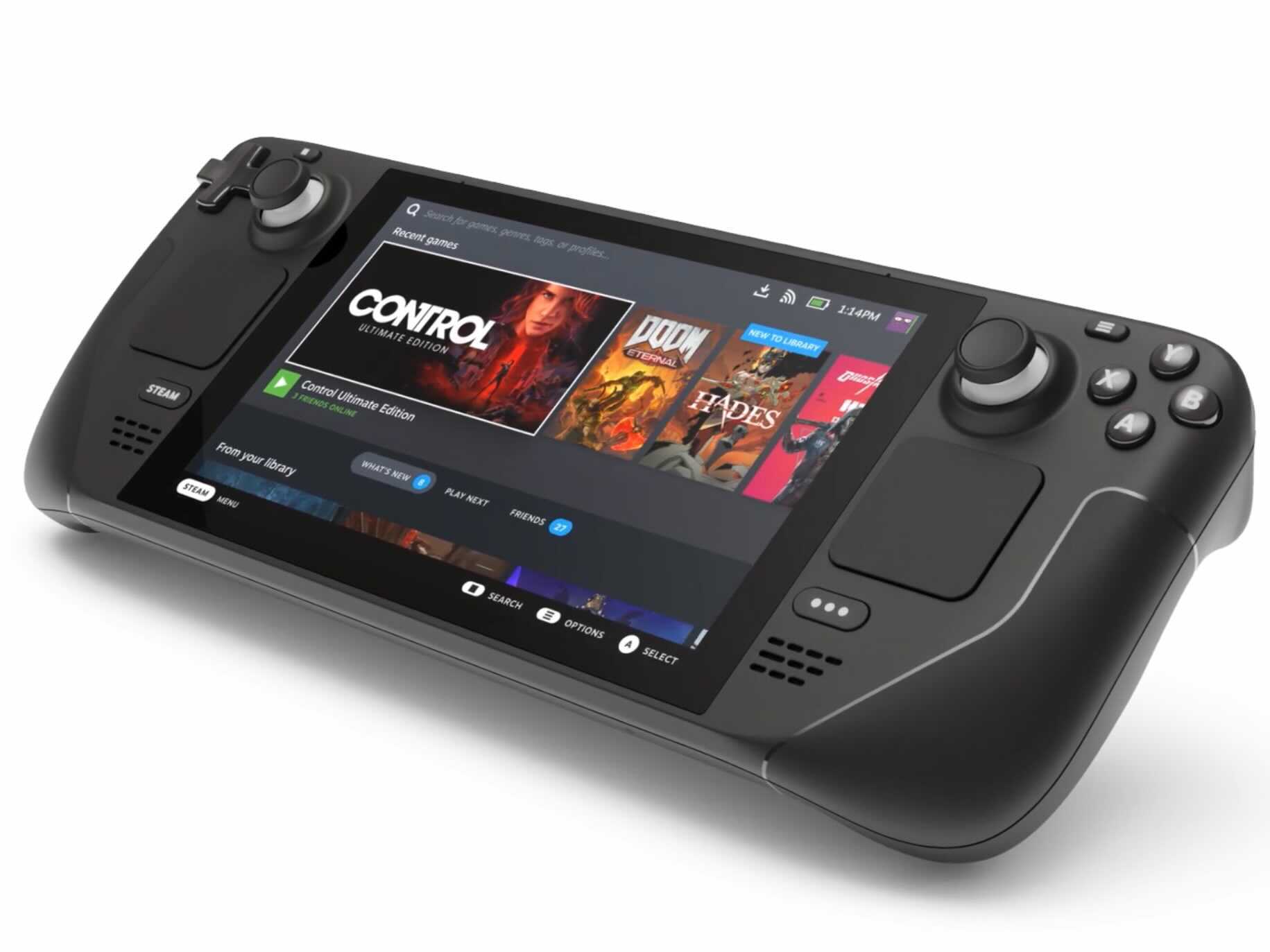You’re not having deja vu. Six years after launching a line of Linux game consoles that went down as one of the biggest tech flops of the past decade, Valve is trying once again. Only this time, its Steam Machine dreams and unusual touchpads have been rolled into a 7-inch handheld PC that looks and works like a Nintendo Switch.
It’s called the Steam Deck, and you can read all about its specs, extensive controls and TV docking station right here.
I’m not deluding myself into thinking it’s a Switch-killer. (Even if the Steam Deck’s $399 starting price might seem close to Nintendo’s $350 Switch with OLED screen, you’re not getting Mario, Zelda and Metroid on a Steam Deck.) But having watched Valve closely over the past nine years, I don’t believe it will flop like the Steam Machines either.
Here are six reasons why this isn’t Steam Machines all over again — and, a few brand-new reasons to be skeptical.
There are plenty of reasons why Valve’s Steam Machines failed, but one towers over the rest: Valve was never in control of its own hardware destiny.
When we exclusively revealed Gabe Newell’s plans for the “Steam Box” in 2013, he originally explained that Valve would sell its own Linux-based living room PC, while simultaneously creating an ecosystem where partners would deliver a wide array of good/better/best boxes as well, creating an entire new category of gaming PC.
But Valve’s own box didn’t make it to market. It never broadly sold the impressive prototype it demonstrated for us in November 2013.
:no_upscale()/cdn.vox-cdn.com/uploads/chorus_asset/file/12803513/STEAM_M_console_controller_hero.1419980053.jpg)
Somewhere along the line, Valve decided to leave the vast majority of the hardware to existing PC manufacturers, whose Steam OS offerings were a mess, running the gamut from “it’s our Windows box, but with fewer games because it’s running Linux” to dubious designs Valve wound up disavowing. Alienware was one of the few to build a bespoke Steam Machine, but it wound up running Windows first instead — because Valve and its hodgepodge collection of partners didn’t manage to launch the Steam Machines initiative until November 2015. By then, that Alienware Alpha had been on sale for nearly a year already.
:no_upscale()/cdn.vox-cdn.com/uploads/chorus_asset/file/19411304/shollister_191126_steam_controller_103959__2_.jpg)
:no_upscale()/cdn.vox-cdn.com/uploads/chorus_asset/file/13456923/shollister_181119_3097_0001_watermark.jpg)
But with the new Steam Deck, Valve is in control once again. We’re not getting a vague time frame for a grand plan to reshape the PC industry, but instead a specific piece of hardware with a specific release window in December 2021. And we have some faith in Valve’s hardware prowess, too, because the company has built up a reputation for excellence. While niche, the Steam Controller and Steam Link wireless box were incredibly smart, well-designed products that deserved better than their eventual fire sales, and Valve set a extremely high bar for PC-tethered virtual reality headsets with the Valve Index and the co-developed HTC Vive.
In 2015, after years of reporting on their promises and possibilities, The Verge warned our readers not to preorder a Steam Machine. The reason had little to do with how long they’d been delayed, and everything to do with how Linux simply didn’t have enough games. We put together a chart of the top 50 games on Steam that made that clear — no Grand Theft Auto V, Fallout or Skyrim, DayZ or any games that weren’t on Steam. Meanwhile, the PS4, Xbox One, and even Windows controller support were looking better and better all the time.
Today, it’s still the case that fewer than 15 percent of all Steam titles officially support SteamOS, but thanks to seeds that Valve planted with Linux nearly a decade ago, the company no longer has to convince developers to port their games from scratch. Many of the officially recognized 8,000 SteamOS titles work thanks to a Proton compatibility layer that lets Windows games run on Linux. Huge competitive shooters like Apex Legends, Destiny 2, PUBG and Fortnite might soon be possible since Valve is working to get their anti-cheat software working ahead of launch. If that happens, most of the top games on Steam should be playable on SteamOS, too.
:no_upscale()/cdn.vox-cdn.com/uploads/chorus_asset/file/22719886/Steam_Deck_touchscreen.jpg)
Perhaps just as importantly, the Steam Deck isn’t chained to Linux. Valve says you can install Windows if you like, as well as other publishers’ stores. And because it’s a PC, you could also fill in the gaming gaps with an array of streaming services like Microsoft xCloud, Google Stadia, Nvidia GeForce Now, Amazon Luna and others if you’re willing to pay, or stream games over your home network from your PlayStation, Xbox or another gaming PC. Good luck doing any of that on Nintendo’s portable.
With Steam Machines, it sometimes felt like Valve was trying to reinvent the wheel. That’s not the case here. Even though most everyone has a smartphone in their pocket these days, video game handhelds are resurgent, thanks to the Nintendo Switch and an array of inspiring concepts that followed in its wake.
The Steam Deck isn’t even the first gaming PC to get Switch-ified: we wrote about how we’re getting closer to a Nintendo Switch-sized gaming PC earlier this year, and for the past few months I’ve been playing with one of them, the crowdfunded Aya Neo. It’s similar to the Steam Deck in that it’s also AMD-powered with joysticks and buttons on both sides of a 7-inch, 1280 x 800 touchscreen. While it’s not powerful enough to competently run demanding games and the software’s a little janky, I played through the majority of Persona 4 Golden and some Star Wars: Squadrons and Outer Wilds on the go, and chatted with buddies on Discord while exploring the deadly plains of Valheim — where the handheld’s AMD Vega 6 graphics did tend to bog down.
[embedded content]
As YouTube gaming handheld expert Taki Udon will tell you, the build quality and ergonomics on these crowdfunded handhelds isn’t always that great, and that’s an opportunity for Valve to flex. Plus, existing handhelds typically cost $700 to $1000. Valve’s asking hundreds of dollars less for the Steam Deck, and with a newer GPU that might bring more games within reach.
In 2020, thirteen years after the most infamous cliffhanger in video game history, Half-Life made its triumphant return with Half-Life: Alyx, a full-length VR-exclusive that quickly shot to the top of “best VR game” lists and reportedly gave the Valve Index headset a huge boost in sales. Ever since, Valve employees have repeatedly hinted that Alyx made them excited about building single-player games again.
:no_upscale()/cdn.vox-cdn.com/uploads/chorus_asset/file/19395801/half_life_alyx_vr_007.jpg)
Valve’s David Speyer told The Verge in 2019 that the company would “love to continue pushing forward” on new Half-Life games, and Gabe Newell told New Zealand’s 1 News in January that it has new single-player games in development. “It’s fun to ship games,” he said, adding that Alyx “created a lot of momentum inside of the company to do more of that.”
With the Steam Deck, Valve may now have an opportunity to use one of those games to jumpstart a platform yet again. If you’ll recall, that’s how the Steam platform made it off the ground in 2004 to begin with — it was the only place to play Half-Life 2 and Valve’s subsequent games. But with Steam Machines, the company opted not to do it, telling me in 2013 that “It’s against our philosophy to put a game in jail and say it only works on Steam Machines.”
That left Valve at the mercy of other developers for games, during an era when it didn’t make many new games of its own. It did bring the then-two-year-old Counter-Strike: Global Offensive, three-year-old Portal 2 and four-year-old Left 4 Dead 2 to Linux in time for the platform’s debut, but there was no good gaming reason to pick a SteamOS box over Windows once the Steam Machines came out.
The Steam Deck is one and a HALF times wider than the Switch, has a battery LIFE of 2-8 hours, and sells for THREE hundred and ninety nine dollars.
— Steve Bailey (@IBasteEvenly) July 16, 2021
But Valve’s philosophy may have evolved. With virtual reality, Valve realized it needed to kickstart the platform, building an incredible showcase with The Lab and then adding system seller Half-Life: Alyx last year, a game it justified keeping VR-exclusive because it was designed explicitly for VR immersion and controls.
I wouldn’t exactly bet on it, but I wouldn’t bet against the idea that Valve could make a similar argument for games that use the Deck’s precision touchpad, touchscreen, touch-sensitive thumbsticks, gyro and rear buttons to emulate the sensation of hands moving around and grabbing things. Valve could build a Half-Life exclusive to portables like this, if not exclusive to the Steam Deck itself. Most PCs certainly don’t have quite this array of input, and it might be a shame if the Deck’s extensive controls were limited to the kind of homegrown controller schemes that Steam Controller fans pump out.
Valve’s Steam Deck might be right on time. Due to the global pandemic, the world’s gamers are acutely aware of who they are. There’s never been a better time to play video games, and demand has never been higher, with US consumers spending more in 2020 than ever before. And while the PS5, Xbox Series X and an array of new PC gaming graphics cards are here, the global chip shortage means you still can’t easily buy them even now, as some of the world is coming out of that pandemic and thinking about leaving the house.
:no_upscale()/cdn.vox-cdn.com/uploads/chorus_asset/file/21867820/twarren_200909_4184_0016.0.jpg)
If you’ve held onto dollars earmarked for those consoles and graphics cards (either because you can’t get one, or are still unconvinced), you might now consider spending that money on a handheld that can accompany you out of the house. There, Nintendo is ready to tempt you with the shiny new OLED-equipped Switch that went on pre-order this past week, but it didn’t announce a Switch Pro. That’s an opportunity for Valve to swoop in: forgetting the Nintendo games, the Steam Deck is about as pro a Switch as you’re liable to get.
But even if the Steam Deck doesn’t attract gamers away from next-gen consoles or graphics cards, that doesn’t mean it’ll flop. So far, every piece of hardware Valve’s built is a gadget its own engineers wanted to see in the world, not a piece of mass-market kit. But if the Steam Deck winds up being a niche product that barely sells, it might still be a success for the company and fans. Some have grown to appreciate what Valve was trying to do with the Steam Controller, for instance, which has a loyal community pumping out custom control schemes for new games last I checked.
The other important thing above Valve building its own hardware is that it can only hurt itself if it fails, and Valve can likely take the pain. According to a recent lawsuit, Valve rakes in an estimated $6 billion in annual revenue from Steam commissions alone, incredible for a company its size, working out to something like $15 million per year per Valve employee.
Besides, Valve seems to be taking a more cautious approach, with buyers putting down $5 deposits to reserve a device, limit 1 per customer, and Valve fulfilling those orders when they’re ready instead of letting a product “sell out.” (It’s incredible that Valve’s the first to try the common-sense approach to preorders we’ve been begging the game industry to adopt for many months with consoles and GPUs.) It might also allow Valve to fulfill orders in small batches instead of investing in a mountain of devices it might have to put on fire sale down the road.
I highly doubt the Steam Deck will be a public flop, but I can imagine a few reasons the PC gaming community won’t wind up embracing it anyhow. For instance, it’s largely priced like a next-gen console with only a fraction of the performance, even if it winds up being more powerful than other handheld PCs on the market.
The $399 base model only comes with 64GB of eMMC flash, too, in an era when a single game can sometimes require more space than that, and when PS5 and Xbox Series X games are beginning to take advantage of the faster load times that speedy NVMe solid state storage can afford. While you can add a microSD card to any model to expand your storage, the speed of your storage might hold the system back some.
Lastly, I’ve got to agree with some of my colleagues with more taste: this is not a particularly good looking machine. It reminds me of the bulbous Wikipad far more than it does a Nintendo Switch, with those thumbsticks mounted high like antennae sticking out of its head.
But I tried the Wikipad, and there’s a reason it was shaped like that: it was designed to be comfortable to hold, not necessarily pleasing for the eyes. I wonder if that’s the idea behind the Deck, too.
In case you’re wondering, I ordered one. We’ll see how it goes.












